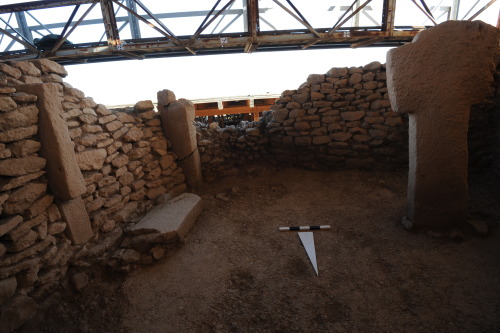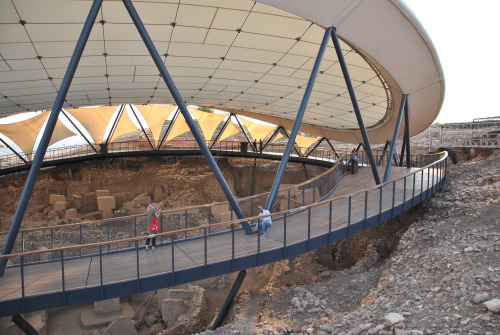
Isn’t it amazing when a thesis reaches the point where the individual chapters form a bigger picture? During the ANAMED 2020–21 year, I was able to define much better the overall framework of my dissertation project, “All Places are Temporary Places – Praktiken des Verlassens und Auflassungsroutinen in der Neolithischen Siedlung Göbekli Tepe” (= “Detachment from Place and Abandonment Routines at the Neolithic Settlement Göbekli Tepe”; working title) and concentrate on writing. My aim is not only to analyze the gradual abandonment of exemplary settlement areas in detail. The latter is, of course, still the focal point of my research. But in addition, I include post-abandonment interactions, as well as the modern impact of excavation infrastructure and tourism at the UNESCO World Heritage Site in the age of the Anthropocene.
Göbekli Tepe (ca. 9500–8000 cal BCE) is well-known for its special buildings with up to 5.5-m-tall monolithic pillars, some of which are decorated with reliefs of wild animals. Additionally, the mound is densely covered with both round/oval and rectangular structures that display long building biographies and multiple phases of re-building and maintenance (Clare 2020; Kinzel and Clare 2020; Kinzel, Duru, and Barański 2020; Knitter et al. 2019). Recent archaeological investigations revealed periodic damage to parts of the settlement by slope slide events (Kinzel, Clare, and Sönmez 2021). As a response, the inhabitants of Göbekli Tepe repaired and remodeled their buildings. Damaged and abandoned structures existed next to permanently occupied ones. It is well known that, in Neolithic settlements, abandoned structures served as middens. Far less is known about the (re-)use of ruins for the extraction of building material. Through my methodology, I demonstrate that the later Pre-Pottery Neolithic B buildings at Göbekli Tepe reveal large quantities of spolia and other secondary and tertiary materials such as ground stone artefacts and re-used wall stones; likewise, large amounts of lithics and animal bone can be traced in the mortar (Schönicke forthcoming). It appears that the use of sterile soil and newly fashioned wall stones was not necessary or even desired by the inhabitants (Fig 1). I then analyze people-ruin interactions and argue that the use of spolia provides indirect evidence for the existence of ruins within the settlement. Using secondary and tertiary materials had many advantages and not only practical ones. The systematic integration of spolia in buildings created spaces of memory and knowledge through continuity. From an archaeological point of view, abandoned areas in settlements are still very underrepresented in reconstruction scenarios, although settlement patterns were likely more diverse than previously suggested.
After 1500 years of occupation, the last inhabitants detached from their place; but, post-abandonment interactions are indicated by surface finds. And now, 12,000 years later, Göbekli Tepe is anything but abandoned. The excavation infrastructure, such as containers, areas for sieving and flotation, a lunch place, the house of the guard, and parking lots, clearly displays a modern occupation. The foundations for the protective roofs were cut through Neolithic layers down to the natural bedrock and filled with concrete. Therefore, it can be said that they became part of the stratigraphy of the site. By definition, the Anthropocene is the irreversible manifestation of human impact on the earth by reshaping the earth’s system and thus becoming a dominant geological factor (Zalasiewicz et al. 2021; Syvitski et al. 2020). In a similar way, the modern impact on Göbekli Tepe cannot be reversed, which makes us part of the settlement, too (Fig. 2). This becomes particularly clear when we imagine future archaeologists examining the site 1000 or 10,000 years from now. Moreover, the promotion of the site for tourism has led to the construction of a visitor center, gift shop and cafe, wooden walkways, and parking lots for buses. Before the pandemic, more than 1000 visitors came to the site per day (Kinzel 2021). This brought the index fossil of the Anthropocene to Göbekli Tepe: plastic. Bottles, wrappings, disposable cutlery, and other items found their way into trenches and the surroundings, even when sites are kept clean (for a survey on plastic remains at an Iron Age site, see Mytum and Meek 2021). As a final step in the framework of my dissertation, I would like to examine the Anthropocene’s impact on Göbekli Tepe in more detail, and I hopefully will be able to work at the site this autumn—if the pandemic situation allows it.

Fig. 2. The main excavation area of Göbekli Tepe with Building B in the west, Building C in the east, and Building D in the north (photo facing west). Room 16 is visible on the right edge of the photo, north of Building D. The protective roof spans the area of the special buildings, with a walkway for visitors underneath. Note the steel beams that reach down to bedrock in the concrete foundations. Photo: M. Arıcı/ Göbekli Tepe Project.
Unfortunately, I could not to come to Istanbul and enjoy the study environment of ANAMED in person, but I really enjoyed our Wednesday Teas and the friendly and collegial atmosphere. Even though we have met only virtually, I am very pleased to have encountered so many interesting scholars and their research. I sincerely thank ANAMED for the opportunity to become part of this excellent academic network. I look forward to visiting ANAMED in the future.
—————————————————————————————————————————————————–
Bibliography
Clare, Lee. 2020. “Göbekli Tepe, Turkey. A Brief Summary of Research at a New World Heritage Site (2015-2019).” E-Forschungsberichte Des DAI 2: 1–13.
Kinzel, Moritz. 2021. “Göbekli Tepe – World Sensation between Scientific Research.” In Archäologische Welterbestätten – Grenzüberschreitend Konservieren, Kommunizieren, Kooperieren/Archaeological World Heritage Sites – Transnational Conservation, Communication, Cooperation, edited by Alexandra Riedel and Stefan Winghart, 104–9. ICOMOS · Hefte Des Deutschen Nationalkomitees, LXXIX. Berlin: Hendrik Bäßler.
Kinzel, Moritz, and Lee Clare. 2020. “Monumental – Compared to What? A Perspective from Göbekli Tepe.” In Monumentalizing Life in Neolithic Europe: Narratives of Continuity and Change, edited by Anne Brigitte Gebauer, Lasse Sørensen, Anne Teather, and Antonio de Valera, 31–50. Oxford: Oxbow Books.
Kinzel, Moritz, Lee Clare, and Devrim Sönmez. 2021. “Built on Rock – towards a Reconstruction of the ’Neolithic’ Topography of Göbekli Tepe.” Istanbuler Mitteilungen 70 (2020), 9–45.
Kinzel, Moritz, Güneş Duru, and Marek Z. Barański. 2020. “Modify to Last. A Neolithic Perspective on Rebuilding and Continuation.” In Umgebaut. Umbau-, Umnutzungs- Und Umwertungsprozesse in Der Antiken Architektur, DiskAB13, edited by Ulrike Wulf-Rheidt, Katja Piesker, and S. Zink, 1–13. Regensburg: Schnell + Steiner.
Knitter, Daniel, Ricarda Braun, Lee Clare, Moritz Nykamp, and Brigitta Schütt. 2019. “Göbekli Tepe: A Brief Description of the Environmental Development in the Surroundings of the UNESCO World Heritage Site.” Land 8 (4:72). https://doi.org/10.3390/land8040072.
Mytum, Harold, and James Meek. 2021. “The Iron Age in the Plastic Age: Anthropocene Signatures at Castell Henllys.” Antiquity 95 (379): 198–214. https://doi.org/10.15184/aqy.2020.237.
Schönicke, Julia. forthcoming. “There and Back Again – Towards a New Understanding of Abandonment Practices at the Neolithic Settlement Göbekli Tepe.” In Proceedings of Broadening Horizons 6, edited by Christian W. Hess and Federico Manuelli. Vol. 1. Berlin: ArchaeoPress (Access Archaeology).
Syvitski, Jaia, Colin N. Waters, John Day, John D. Milliman, Colin Summerhayes, Will Steffen, Jan Zalasiewicz, et al. 2020. “Extraordinary Human Energy Consumption and Resultant Geological Impacts Beginning around 1950 CE Initiated the Proposed Anthropocene Epoch.” Communications Earth & Environment 1 (1): 32. https://doi.org/10.1038/s43247-020-00029-y.
Zalasiewicz, Jan, Colin N. Waters, Erle C. Ellis, Martin J. Head, Davor Vidas, Will Steffen, Julia Adeney Thomas, et al. 2021. “The Anthropocene: Comparing Its Meaning in Geology (Chronostratigraphy) with Conceptual Approaches Arising in Other Disciplines.” Earth’s Future 9 (3): e2020EF001896. https://doi.org/10.1029/2020EF001896.

